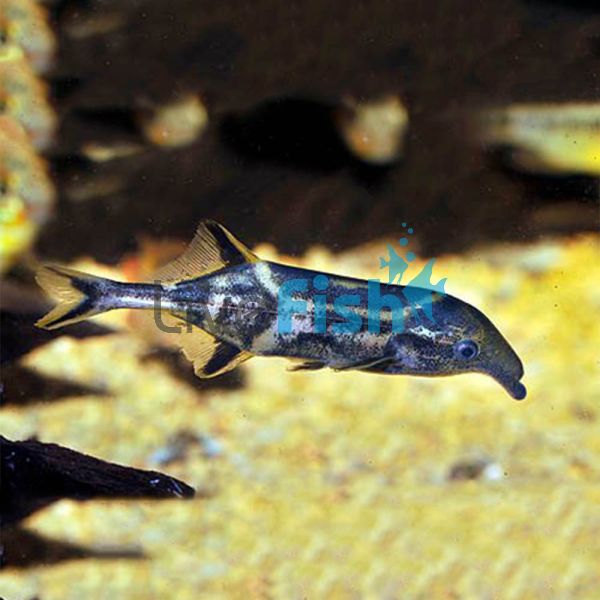Angolan Elephant Nose - Wild Caught 12cm
For the aquarists chasing a real oddball fish, the Angolan Elephant Nose is a unique specimen that ticks every box. Easily one of the weirdest looking fish, the Angolan Elephant Nose is an incredibly interesting fish in its behaviour looks and colour. This species in particular tends to be rarer than the other elephant nose species (Gnathonemus Petersii), this species also gets larger. These will be the perfect species to have in a single species biotope style display and act as a real intriguing showpiece fish.
Angolan Elephant Nose
For the aquarists chasing a real oddball fish, the Angolan Elephant Nose is a unique specimen that ticks every box. Easily one of the weirdest looking fish, the Angolan Elephant Nose is an incredibly interesting fish in its behaviour looks and colour. This species in particular tends to be rarer than the other elephant nose species (Gnathonemus Petersii), this species also gets larger. These will be the perfect species to have in a single species biotope style display and act as a real intriguing showpiece fish.
Angolan Elephant Nose gets its name from the elephant trunk-style appendage they have on the lower jaw. This species in particular also has a downwards-pointing upper jaw which gives the appearance of two trunks, though this seems like their nose it is an electrical receptor vital to the lifestyle of this fish. They use this to emit a very faint electrical signal to strategically find prey items hidden in sandy substrates and murky waters. This electric signal however is too small to be felt by hand.
Though the colours on this fish aren’t as crazy as say an African cichlid the simplicity of its mottled brown and grey patterning gives it a very mysterious, ominous look. The base colour is jet black which is broken by a peppered brown array of segmented lines that adds to the alien look of this fish. The Angolan Elephant Nose also gets to around 20 cm and is known to be quite a peaceful fish however is best to be kept alone as multiple elephant nose fish can get aggressive with each other.
Trying to differentiate males and females in this species is extremely difficult and breeding them in the home aquarium hasn’t been recorded as very little information is known about the lifecycle of this species. However, they do make a great bottom-dwelling species to an oddball aquarium and their native range is from Africa.
Tank Recommendations for your Elephant Nose
The Elephant Nose is a relatively large growing fish, though you might not see it for most of the day due to its nocturnal behaviour it is quite active during dim lighting and at night. Because of this, it does require a decent-sized aquarium of around 200 liters with a decent footprint compared to height. A sand substrate is best as any coarse substrate could rupture or irritate their sensitive electroreceptor organ as they search for food. Additions of driftwood, leaf litter, and botanicals would be appreciated along with a dense plant cover. When selecting plants, it is best to go for heavy-rooting plants to avoid them being dug out. Such deep-rooted species include Wisteria, Vallisneria, and Crypts. As these fish are also mostly nocturnal, dim lighting would be better to bring them out during the day.
Suitable Tank Buddies
Elephant Noses are fairly peaceful fish and can be kept with a wide variety of soft water fish. They have been safely housed with smaller species due to their nature however it might be better to avoid very small and slow-moving fish because the poor eyesight could result in a nano fish like a neon tetra being eaten accidentally.
Usually Compatible
Top dwelling species such as Giant Danios and Hatchet Fish, and a wide range of medium-sized tetras such as Black Widows, Rosy Tetras, and Black neon Tetras.
Sometimes Compatible
Medium-sized and relatively peaceful cichlids such as Geophagus, Kribensis, Jewel Cichlids, and species of a similar sort.
Rarely Compatible
Shrimp and nano aquarium fish like Neon Tetras, and Ember Tetras, and very aggressive South American cichlids such as Oscars and Jaguar Cichlids.
Feeding your Elephant Nose
Some ripe bananas and large bales of hay… sorry wrong elephant nose. So, this fish is a very opportunistic feeder however there might be some issues getting them on prepared aquarium feeds such as pellets. It might be better to begin feeding them with live black or blood worms or frozen meaty foods like brine shrimp. Once they are seen eating an attempt to get them eating small sinking pellets can be made and they should take to them quickly. To experience their wild feeding behaviour it would be interesting to add live black worms into the substrate with an aquarium siphon. These should dig into the sand quickly and the elephant nose should then begin to hunt them down strategically using its electric receptors.
| Scientific Name | Campylomormyrus cassaicus |
|---|---|
| Care Level | Moderate |
| Common Names | Angolan Elephant Nose |
| Diet | Carnivore |
| Fish Family | Mormyridae |
| Lifespan (years) | 9 |
| Max. Length (cm) | 22 |
| Min. Tank Volume (l) | 200 |
| Origin | Africa |
| Reef Safe | Yes |
| Sociability | Peaceful |
| Venomous | No |
| Water Conditions | 24-26° C, pH 6.0 - 7.0 |




